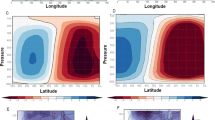Abstract
By using a nine-layer global spectral model involving fuller parameterization of physical processes, with a rhomboidal truncation at wavenumber 15, experiments are performed in terms of two numerical schemes, one with long-term mean coverage of Arctic ice (Exp.1), the other without theice (Exp.2). Results indicate that the Arctic region is a heat source in Exp.2 relative to the case in Exp.1. Under the influence of the polar heat source simulated, there still exist stationary wavetrains that produce WA-EUP and weakPNA patterns in Northern winter. That either the Arctic or the tropical heat source can cause identical climatic effects is due to the fact that the anomaly of the Arctic ice cover will directly induce a south-propagating wavetrain, and bring about the redistribution of the tropical heat source/sink. The redistribution is responsible for new wavetrains that will exert impact on the global climate. The simulation results bear out further that the polar region in Exp.2 as a heat source, can produce, by local forcing, a pair of positive and negative difference center, which circle the Arctic moving eastwards. Observed in the Northem Hemisphere extratropics is a 40–50 day oscillation in relation to the moving pair, both having the same period.
Similar content being viewed by others
References
Geisler, J. E., M. L. Blackmon, G. T. Bates and S. Munoz (1985), Sensitivity of January climate response to the magnitude and position of equatorial Pacific sea surface temperature anomalies,J. Atmos. Sci.,42: 1037–1949.
McAvaney, B., M. Bourke and K. puri (1978), A global spectral model for simulation of the general circulation,J. Atmos. Sci.,35: 1557–1583.
Ni Yunqi and Lin Wuyin (1990), Short-term climatic oscillations forced by E1 Nino in the Northern winter (to be published inA.A.S.).
Ni Yunqi, Zhang Qin and Li Yaodong (1990), Numerical study for influence mechanism of Arctic ice cover on short-term climate during the Northern summer (to be published inActa Meteorologica Sinica).
Nitta, T. (1987), Convective activities in the tropical western Pacific andtheir impact on the Northern Hemisphere summer circulation,Proceedings of International Conference on the General Circulation of East Asia, April 10–15, 1987, Chengdu, China.
Shukla, S. and J.M.. Wallace (1983), Numerical simulation of the atmospheric response to equatorial Pacific sea surface temperature anomaties,J. Atmos. Sci.,40: 1613–1630.
Wallace, J. M. and D. S. Gutzler (1981), Teleconnections in the geopotential height field during the Northern H Hemisphere winter,Mon. Wea. Rev.,109: 784–812.
Author information
Authors and Affiliations
Rights and permissions
About this article
Cite this article
Yunqi, N., Qin, Z. & Yuedong, L. A numerical study of the mechanism for the effect of northern winter arctic ice cover on the global short-range climate evolution. Adv. Atmos. Sci. 8, 489–498 (1991). https://doi.org/10.1007/BF02919271
Received:
Revised:
Issue Date:
DOI: https://doi.org/10.1007/BF02919271




